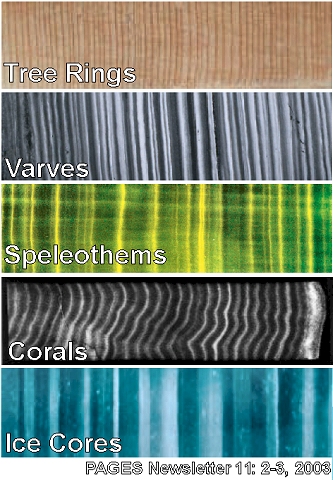 The Quaternary Period spans the last 2.6 million years of the Earth’s history.
The Quaternary Period spans the last 2.6 million years of the Earth’s history.
The Quaternary is an interval with dramatic and frequent changes in global climate. Warm interglacials alternated with cold ice ages.
Quaternary scientists use their expertise to interpret past climate variability from a range of archives, but also look at how past climate has shaped our current landforms and ecosystems.
 Quaternary archives can be found in lakes or bogs, caves, glaciers and ice caps, coastal and marine environments. The ideal archive is one that provides a continuous record over thousands, to millions, of years. For example a long sedimentary core from a lake or marine environment with continuous sedimentation, or an ice core which has accumulated layers of ice each year. Other episodic archives can also provide useful information to understand the past climate system. Dunes, glacial moraines, lakes and river channels can be dated to look for periods of fluvial activity or dune building.
Quaternary archives can be found in lakes or bogs, caves, glaciers and ice caps, coastal and marine environments. The ideal archive is one that provides a continuous record over thousands, to millions, of years. For example a long sedimentary core from a lake or marine environment with continuous sedimentation, or an ice core which has accumulated layers of ice each year. Other episodic archives can also provide useful information to understand the past climate system. Dunes, glacial moraines, lakes and river channels can be dated to look for periods of fluvial activity or dune building.
There is a range of different techniques used to date and analyse Quaternary archives. These range from fossil assemblages (usually microfossils, but also teeth, larger invertebrates), geochemical changes (radioactive or stable isotopes, biomarkers, trace elements), physical properties (grain size, luminescence, mineralogy).
Quaternary scientists spend a lot of time in the outdoors observing and collecting their samples. They need to be multidisciplinary and can be found in a wide range of university departments (geography, earth sciences, archaeology, coastal and marine sciences) and organisations (local and central government, geological surveys, consultancies).
Quaternary palaeoclimatic investigations provide an understanding of the past variability in the background natural climate. This information, along with climate models, plays a key role in the understanding the drivers and feedbacks of the global climate. A good understanding of past climatic conditions and the factors that control climate change will provide a robust scientific basis for anticipating or predicting future change
AQUA was formed in 1987, by a small group of researchers at a conference in Mildura, Victoria, Australia. It aims to bring together researchers that study the Quaternary climate and landscape changes in the diverse and spectacular Australasian region, which extends from Antarctica to the tropics. The organisation aims to provide a forum for Quaternary Researchers working in this region to collaborate. There have been a range of AQUA projects over the past 25 years.
We organise biennial conferences and members also participate in the INQUA (International union for Quaternary Research) conferences every 4 years.
Quaternary Australasia is a biannual magazine with articles and highlights of research from this region.
It also seeks to encourage research by younger workers in particular, by helping them to attend meetings and conferences and promote their work and the region. AQUA also encourages early career researchers to get involved with running the organisation and there are several early career researchers on the committee.
Join the AQUA mailing list – AQUAlist – to receive information on Quaternary topics and upcoming events. To subscribe/unsubscribe to this list go to http://mailman.anu.edu.au/mailman/listinfo/aqualist.
The list can be used to notify other members of the Quaternary community of job vacancies, upcoming conferences, funding opportunities and new research. It can also serve as an unmoderated forum for discussion of Quaternary topics. Subscribing members can send their messages to:
Please do not send large attachments and only send stuff that is relevant to the Quaternary community in Australia/New Zealand.
AQUA acknowledges the traditional owners of the lands and seas of Australasia on which we live, work and conduct research, and we pay our respects to Elders past and present.